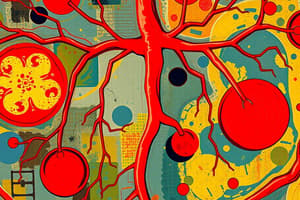Podcast
Questions and Answers
What is the primary function of erythrocytes in the blood?
What is the primary function of erythrocytes in the blood?
The primary function of erythrocytes is to transport oxygen and carbon dioxide within the body.
Explain how leucocytes contribute to the immune system.
Explain how leucocytes contribute to the immune system.
Leucocytes defend against infections by detecting abnormal materials, producing antibodies, and destroying infected or cancerous cells.
Describe the role of platelets in the blood.
Describe the role of platelets in the blood.
Platelets help to form blood clots by clumping together to slow or stop bleeding.
What is the significance of plasma in the blood?
What is the significance of plasma in the blood?
How does the structure of erythrocytes aid in their function?
How does the structure of erythrocytes aid in their function?
Where are lymphocytes primarily produced, and what is their function?
Where are lymphocytes primarily produced, and what is their function?
Identify one major difference between monocytes and other white blood cells.
Identify one major difference between monocytes and other white blood cells.
What key function distinguishes B-cells from T-cells in the immune response?
What key function distinguishes B-cells from T-cells in the immune response?
Flashcards
B-Cells
B-Cells
A type of white blood cell responsible for producing antibodies, which are proteins that destroy harmful microorganisms like bacteria.
T-Cells
T-Cells
A type of white blood cell that directly attacks cells infected by viruses or those that have become cancerous.
Plasma
Plasma
The liquid component of blood that carries various substances throughout the body, including nutrients, gases, and waste products.
Blood Clotting
Blood Clotting
Signup and view all the flashcards
Erythrocytes
Erythrocytes
Signup and view all the flashcards
Leucocytes
Leucocytes
Signup and view all the flashcards
Temperature Regulation in Blood
Temperature Regulation in Blood
Signup and view all the flashcards
Nutrient Transport in Blood
Nutrient Transport in Blood
Signup and view all the flashcards
Study Notes
Functions of Blood
- Blood transports oxygen and carbon dioxide throughout the body
- Red blood cells (erythrocytes) lack a nucleus, maximizing space for hemoglobin
- Hemoglobin combines with oxygen, enabling efficient oxygen transport
- Erythrocytes have a bi-concave shape for maximizing surface area for oxygen exchange
- Erythrocytes are small and flexible, allowing them to pass through narrow capillaries
- Leucocytes (white blood cells) defend the body against infection, detecting and destroying abnormal materials, pathogens, viruses, and toxins
- B-cells produce antibodies to combat antigens like bacteria
- T-cells destroy body cells infected by viruses or cancerous cells
- Neutrophils combat bacterial infections
- Monocytes are part of the immune system, formed in the bone marrow and entering the bloodstream/tissues to fight off germs
- Platelets clump together to form blood clots, preventing excessive bleeding and helping wounds heal
- Plasma is a liquid containing suspended blood cells and transport medium for glucose, lipids, amino acids, hormones, dissolved food molecules, carbon dioxide, and oxygen
- Plasma plays a role in temperature regulation of the body
Studying That Suits You
Use AI to generate personalized quizzes and flashcards to suit your learning preferences.




